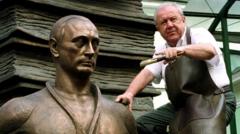Georgian-Russian artist Zurab Tsereteli, whose enormous and often polarizing sculptures left an indelible mark on the art world, has died at the age of 91. Born in Tbilisi, Tsereteli achieved fame during the Soviet era, becoming known for his iconic large-scale works, including the towering 98-meter (321-foot) monument to Tsar Peter the Great in Moscow.
Tsereteli's career spanned several decades, starting with his prominence during the Soviet Union's 1980 Olympic Games, for which he led the design team. His sculptures can be found across various cities worldwide, embodying a unique fusion of artistry and political resonance. Notably, he designed a grand monument to Christopher Columbus, which stands in Puerto Rico, as well as the controversial Tear of Grief memorial in New Jersey, dedicated to the victims of the 9/11 attacks.
His close ties with Russia's political elite, including personal friendships with key figures such as Mayor Yuri Luzhkov and President Vladimir Putin, fueled his creative endeavors. Tsereteli once expressed that Putin's "healthy soul" inspired him to create a poignant bronze study of the president. This close connection to political power often drew both admiration and criticism, underscoring a complex relationship with the authorities of the time.
The artist's work frequently sparked debate among the public, particularly regarding the Peter the Great monument, which some in Moscow derided as an eyesore. Despite this mixed reception, he remained highly regarded in artistic circles and served as president of the Russian Academy of Arts. His creations also highlight significant historical moments, such as Good Defeats Evil at UN Headquarters, symbolizing the end of nuclear warfare with dramatic imagery of St. George slaying the dragon.
Tsereteli's artistic legacy is a multifaceted narrative of grandeur, controversy, and international engagement. As a painter and architect, he contributed significantly to Moscow's architectural landscape, including the reconstruction of the Cathedral of Christ the Saviour. His work, ranging from monumental sculptures to intimate studies, reflects a lifelong commitment to exploring the intersections of art, history, and politics, ensuring that his influence endures long after his passing.


















